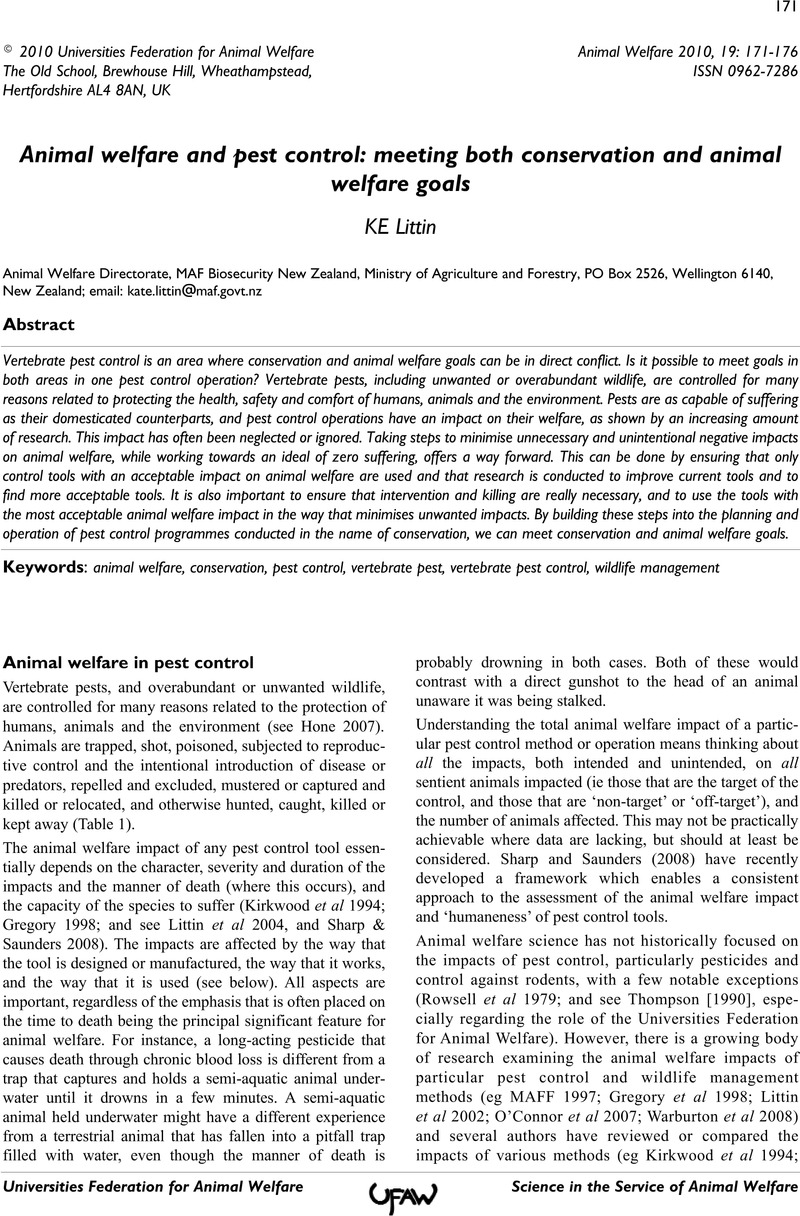Crossref Citations
This article has been cited by the following publications. This list is generated based on data provided by Crossref.
Fraser, D
2010.
Toward a synthesis of conservation and animal welfare science.
Animal Welfare,
Vol. 19,
Issue. 2,
p.
121.
Parsons, Michael H.
Blumstein, Daniel T.
and
Dods, Kenneth C.
2012.
An in situ vertebrate bioassay helps identify potential matrices for a predator‐based synthetic management tool.
Wildlife Society Bulletin,
Vol. 36,
Issue. 2,
p.
383.
Gerritzen, MA
Reimert, HGM
Lourens, A
Bracke, MBM
and
Verhoeven, MTW
2013.
Killing wild geese with carbon dioxide or a mixture of carbon dioxide and argon.
Animal Welfare,
Vol. 22,
Issue. 1,
p.
5.
Ben-Ami, D
Boom, K
Boronyak, L
Townend, C
Ramp, D
Croft, DB
and
Bekoff, M
2014.
The welfare ethics of the commercial killing of free-ranging kangaroos: an evaluation of the benefits and costs of the industry.
Animal Welfare,
Vol. 23,
Issue. 1,
p.
1.
Farnworth, Mark J.
Watson, Helen
and
Adams, Nigel J.
2014.
Understanding Attitudes Toward the Control of Nonnative Wild and Feral Mammals: Similarities and Differences in the Opinions of the General Public, Animal Protectionists, and Conservationists in New Zealand (Aotearoa).
Journal of Applied Animal Welfare Science,
Vol. 17,
Issue. 1,
p.
1.
Hampton, JO
Forsyth, DM
Mackenzie, DI
and
Stuart, IG
2015.
A simple quantitative method for assessing animal welfare outcomes in terrestrial wildlife shooting: the European rabbit as a case study.
Animal Welfare,
Vol. 24,
Issue. 3,
p.
307.
Fisher, Penny
Algar, David
Murphy, Elaine
Johnston, Michael
and
Eason, Charles
2015.
How does cat behaviour influence the development and implementation of monitoring techniques and lethal control methods for feral cats?.
Applied Animal Behaviour Science,
Vol. 173,
Issue. ,
p.
88.
Beausoleil, NJ
and
Mellor, DJ
2015.
Advantages and limitations of the Five Domains model for assessing welfare impacts associated with vertebrate pest control.
New Zealand Veterinary Journal,
Vol. 63,
Issue. 1,
p.
37.
Ramp, Daniel
and
Bekoff, Marc
2015.
Compassion as a Practical and Evolved Ethic for Conservation.
BioScience,
Vol. 65,
Issue. 3,
p.
323.
Goldson, SL
Bourdôt, GW
Brockerhoff, EG
Byrom, AE
Clout, MN
McGlone, MS
Nelson, WA
Popay, AJ
Suckling, DM
and
Templeton, MD
2015.
New Zealand pest management: current and future challenges.
Journal of the Royal Society of New Zealand,
Vol. 45,
Issue. 1,
p.
31.
Ramp, Daniel
and
Bekoff, Marc
2016.
Animal Ethics in the Age of Humans.
Vol. 23,
Issue. ,
p.
387.
Sparrow, Elisa E.
Parsons, Michael H.
and
Blumstein, Daniel T.
2016.
Novel use for a predator scent: preliminary data suggest that wombats avoid recolonising collapsed burrows following application of dingo scent.
Australian Journal of Zoology,
Vol. 64,
Issue. 3,
p.
192.
Zemanova, Miriam A.
2017.
More Training in Animal Ethics Needed for European Biologists.
BioScience,
Vol. 67,
Issue. 3,
p.
301.
van Gerwen, M.A.A.M.
and
Meijboom, F.L.B.
2018.
62. The black box of rodents perceived as pests: on inconsistencies, lack of knowledge and a moral mirror.
p.
392.
Beausoleil, Ngaio J.
Mellor, David J.
Baker, Liv
Baker, Sandra E.
Bellio, Mariagrazia
Clarke, Alison S.
Dale, Arnja
Garlick, Steve
Jones, Bidda
Harvey, Andrea
Pitcher, Benjamin J.
Sherwen, Sally
Stockin, Karen A.
and
Zito, Sarah
2018.
“Feelings and Fitness” Not “Feelings or Fitness”–The Raison d'être of Conservation Welfare, Which Aligns Conservation and Animal Welfare Objectives.
Frontiers in Veterinary Science,
Vol. 5,
Issue. ,
Lynn, William S.
Santiago‐Ávila, Francisco
Lindenmayer, Joann
Hadidian, John
Wallach, Arian
and
King, Barbara J.
2019.
A moral panic over cats.
Conservation Biology,
Vol. 33,
Issue. 4,
p.
769.
Mankad, Aditi
Kennedy, Uttara
and
Carter, Lucy
2019.
Biological control of pests and a social model of animal welfare.
Journal of Environmental Management,
Vol. 247,
Issue. ,
p.
313.
Nieuwland, J.
van Gerwen, M.A.A.M.
and
Meijboom, F.L.B.
2019.
34. Rumble in the urban jungle: moral dilemmas in the management of liminal rodents perceived as pests.
p.
247.
Johnston, Michael
Algar, Dave
O'Donoghue, Michael
Morris, Jim
Buckmaster, Tony
and
Quinn, Julie
2020.
Efficacy and welfare assessment of an encapsulated para-aminopropiophenone (PAPP) formulation as a bait-delivered toxicant for feral cats (Felis catus).
Wildlife Research,
Vol. 47,
Issue. 8,
p.
686.
Beausoleil, Ngaio J.
2020.
I Am a Compassionate Conservation Welfare Scientist: Considering the Theoretical and Practical Differences Between Compassionate Conservation and Conservation Welfare.
Animals,
Vol. 10,
Issue. 2,
p.
257.



